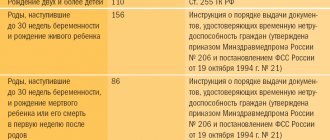The length of the working day or shift immediately preceding a non-working holiday is reduced by one hour.
In continuously operating organizations and in certain types of work, where it is impossible to reduce the duration of work (shift) on a pre-holiday day, overtime is compensated by providing the employee with additional rest time or, with the employee’s consent, payment according to the standards established for overtime work.
On the eve of the weekend, the duration of work in a six-day work week cannot exceed five hours.
Commentary on Article 95 of the Labor Code of the Russian Federation
1. Non-working holidays are defined in Art. 112 TK.
2. According to Part 1 of the commented article, the duration of the working day or shift immediately preceding a non-working holiday is reduced by one hour both for workers with normal working hours and for those who work on reduced working hours, regardless of the basis for it abbreviations.
If a non-working holiday follows a day off, then the working day preceding this day off is not subject to reduction. If a week falls on a holiday, the working hours for that week are adjusted accordingly. This rule applies to both a five-day and a six-day work week.
3. The main form of compensation for overtime on a pre-holiday day in continuously operating organizations and in certain types of work where it is impossible to reduce the duration of work (shift) is to provide the employee with additional rest time. Compensation for such overtime should be provided for in the shift schedule. If in an organization this issue is not regulated by a shift schedule or a collective agreement, then additional rest time is provided by agreement of the parties. Replacing overtime with payment according to the standards established for overtime work is allowed only with the consent of the employee.
Pre-holiday day under labor law - personnel registration mechanism
In what order are data on pre-holiday shortening of a work shift (day) reflected in timesheets? You can use the statistical coding of designations from Resolution No. 1 or create your own codes. Staff attendance is indicated by the letter “I” or the numbers “01”. Separate lines indicate the number of hours worked. For example, in 2021, March 8 is an official non-working day. And March 7 is a pre-holiday date with the duration of work not 8 hours, but 7 (for people on a 5-day week). This means that the personnel officer will assign such employees not 8 hours for March 7, but 7 hours.
Many enterprises believe that since such a reduction relates to the legal norm while maintaining the full salary, then there is no need to indicate a smaller number of hours on the timesheet. However, this position is incorrect. If a labor inspection is carried out, the inspector will regard this as a violation of the labor rights of workers and will consider that the citizen was forced to work overtime without paying compensation for overtime. Therefore, you need to literally follow the law and enter the required number of hours when reducing the working hours of specialists on the eve of official holidays.
Conclusion - in this article we figured out how the Labor Code interprets a shortened working day: the pre-holiday return to work must be reduced by one hour. The labor standard applies to core and part-time employees, as well as part-time workers. In this case, there is no reduction in wages, and a special mark is added to the time sheet.
Another commentary on Article 95 of the Labor Code of the Russian Federation
The commented article provides that the length of the working day (shift) immediately preceding a non-working holiday is reduced by one hour. In certain types of work or in continuously operating organizations where such a reduction in work duration is not possible, overtime is compensated by providing additional rest time to the employee or, with his consent, payment according to the standards established for payment of overtime work. For employees who have a six-day working week, the duration of work on the eve of the weekend cannot exceed five hours.
If a holiday is preceded by a day off, the length of the working day (shift) is not reduced.
Categories of employees who are granted reduced working hours
Based on Art. 92 of the Labor Code of the Russian Federation, the groups of persons for whom a shortened day is the norm are as follows:
- the working time of minor employees under 16 years of age is reduced to 24 hours a week;
- for persons from 16 to 18 years old there is a limit of 35 hours per week;
- disabled people of groups 1 and 2 have the right to work a maximum of 35 hours a week;
- employees performing their duties in harmful and/or dangerous conditions work a maximum of 36 hours per week.
Also, on the basis of Art. 93 of the Labor Code of the Russian Federation, the employer can provide temporary part-time work to such subordinates:
- women expecting a child;
- one of the parents (or guardian/trustee) who is caring for a child under 14 years of age;
- a person caring for a disabled minor;
- a person caring for a seriously ill relative under a medical prescription.
Shortened day for minors, education and medical workers
When considering the features of the conditions of short-time work, it is advisable to consider, in addition to Art. 92, art. 94 Labor Code of the Russian Federation. It determines the immediate duration of the work shift. Thus, the following provisions can be distinguished:
- for minor citizens from 15 to 16 years old - 5 hours a day;
- for persons from 16 to 18 years old - 7 hours;
- for subjects from 14 to 16 years old who are currently receiving education at technical schools or colleges, and combine it with work throughout the year - 2.5 hours;
- for persons combining study and work, from 16 to 18 years old - 4 hours.
In addition to citizens under 18 years of age, special working conditions are provided for teachers and doctors.
Such labor circumstances for persons associated with teaching activities are enshrined in specialized standards created by the Ministry of Education and Science of the Russian Federation. Thus, for this category, a provision is fixed, based on which the number of working hours per week should not exceed 36. When determining the specific number of hours, the specialty and position of the subject are taken into account. In particular, a shortened week is expected for:
- Teachers and professors of universities and institutions involved in providing the population with additional education.
- Senior educators of children's educational organizations, orphanages, as well as institutions involved in additional education of the younger population.
- Social educators and psychologists of educational institutions, children's camp counselors.
- Methodists and tutors (scientific supervisors or mentors).
- Managers of institutions involved in the physical education of children.
- Teachers providing pre-conscription training.
For persons engaged in medical activities, the length of the working day is determined in PP No. 101 of February 14, 2003. The frequency of one work shift depends on the employee’s group. The resolution provides for three categories of doctors who can work 36, 33 and 30 hours a week, based on their place of work and position.
Part time
Part-time work is fundamentally different from short-time work in the most important way - remuneration. If, with a shortened working day, payment is the same as for a full-time rate, then with a part-time working day, it is calculated in proportion to the time worked.
In other words, if an employee has agreed with the employer on a 30-hour work week instead of a 40-hour week, then he will receive 25% less salary (unless, of course, he has a completely piece-rate wage).
Any employee can go part-time if he agrees with the employer (that is, if both parties agree to this provision). There is also a list of preferential categories that the employer is obliged to let go on a part-time basis.
:
- pregnant women - on the basis of a certificate from a medical institution;
- one of the parents (or guardian) of a child under 14 years of age or a disabled child under 18 years of age;
- persons who care for a sick family member - based on a medical report.
The law does not specify how much working hours can be reduced. Eligible beneficiaries decide independently
, how many hours a week and what schedule they should work on.
A reduction in the length of the working day, a reduction in the number of working days per week, or a mixed option is allowed. The desired work schedule is indicated in the application to the employer, and then fixed in an additional agreement to the employment contract.
Typically, employers accommodate employees halfway and agree to a request to reduce the working week. If the employer does not agree, the employee goes to the state labor inspectorate, which usually resolves the issue in favor of the employee
. If there is no result, you can go to court.
The reduction in working hours must be reasonable, otherwise even the court will not help. For example, there was a case where a nurse in a hospital asked to set a work schedule of 0.5 hours per week (Monday, from 8:00 to 8:30). As a result, the court decided the dispute in favor of the hospital.
Expert opinion
Polyakov Pyotr Borisovich
Lawyer with 6 years of experience. Specialization: civil law. More than 3 years of experience in drafting contracts.
In Russian realities, not everyone will want to argue and sue their employer, because this will directly affect the attitude towards the employee (unless, of course, he works for a giant like Russian Railways). But it is worth remembering that the labor inspectorate and the court usually side with the employee.
Interestingly, Rostrud clarified back in 2007 that work beyond the established part-time schedule should be paid as overtime hours
. That is, if you work 40 hours a week on an agreed-upon 30-hour schedule, 10 hours will be paid at an increased rate.
In times of crisis, part-time work is sometimes set by the employer himself. The law allows this only in some cases - when organizational or technological working conditions change in such a way that without the introduction of part-time work, 10% or more of employees will have to be laid off.
The employer is obliged to warn about this in advance - at least 2 months before the introduction of the new schedule
. An order is issued that is agreed upon with the trade union (if there is one) and which employees must familiarize themselves with.
If the employee agrees, he signs an additional agreement to the employment contract with new working time conditions. If he does not agree and has not signed this agreement, after the introduction of the new schedule, the employment contract with him will be terminated (that is, he will be fired).
This dismissal will be formalized according to all the rules as a dismissal due to reduction, with all due compensation.
Most often, employers introduce a partial schedule, justifying this with a difficult financial situation. Formally, this reason is not valid, but usually there is indeed a risk of mass layoffs.
Part-time work at the initiative of the employer can be introduced for a maximum of 6 months
. If it is reintroduced, then the reasons must be different (otherwise the labor inspectorate or court will impose a fine on the employer).
Should the standard working hours according to the production calendar be reduced for employees for June?
According to Decree of the President of the Russian Federation dated May 29, 2020 No. 345, June 24, 2020 was declared a non-working day with continued pay. It should be noted that the rule on maintaining wages is similar to the provisions of Decrees of the President of the Russian Federation dated March 25, 2020 No. 206, dated April 2, 2020 No. 239, and dated April 28, 2020 No. 294.
Currently, the Labor Code of the Russian Federation and other regulatory legal acts do not contain a normative definition of non-working days. But according to the explanations of the Ministry of Labor of Russia, which were posted on April 2, 2020 on the official website of the department, payment to employees for the non-working period must be made in full, which means that this period must be paid as if the employee was working. Based on this, the time standard remained unchanged during non-working days from March 30 to April 30 and from May 6 to 8. Similar explanations were given on the regional websites of Rostrud.
Today this question does not have a clear answer. Based on the definition of working time according to Article 91 of the Labor Code of the Russian Federation, as well as the Procedure for calculating the norm of working time (approved by Order of the Ministry of Health and Social Development of the Russian Federation of August 13, 2009 No. 588n), non-working days should not be included in the norm of working time. But you should pay attention to the fact that with regard to June 24, the situation is different in that, in accordance with Decree of the President of the Russian Federation No. 345, this day is declared a non-working day for all workers, without any distinction by industry and type of activity.
In accordance with Decrees of the President of the Russian Federation dated March 25, 2020 No. 206, dated April 2, 2020 No. 239, and dated April 28, 2020 No. 294, only certain organizations had the right to continue working during non-working days from March 30 to May 11. This was directly provided for by these Decrees of the President of the Russian Federation.
So the final decision remains with the organization. Please note that the production calendar is posted in the legal reference system, which contains two options: without taking into account the reduction in working hours due to a non-working day with the same wages, and taking into account the reduction.
How to take this day into account on the timesheet?
If the employee is hired on June 24, 2021, use the letter code “I”. If the employee did not work on June 24, you can use your own special code (for example, GCD or OH).
So, June 24 is a non-working day with employees maintaining their wages. June 24 is not a day off.
June 24 does not affect the duration of vacation and is included in the number of calendar days of vacation.
A non-working day on June 24, 2021 does not reduce the working hours in June, this is our opinion, and companies will have to make the final decision on their own.
Now let's deal with July 1, 2021
The procedure for payments for performing labor duties on shortened working days
Groups of subjects for whom such a schedule is standard have the right to claim the full amount of wages despite the smaller number of hours worked provided for by the general schedule.
A separate category includes employees who have not yet turned 18 years of age. When calculating wages for the specified group of persons, the reduced time is taken into account. That is, final payments to a minor subject will be made in proportion to the work schedule without taking into account age. However, the employer has the right to supplement payments to minor employees using the company’s personal funds.
Another nuance of this issue is the payment of wages to disabled people. Based on Art. 23 Federal Law No. 181 “On the social protection of disabled people in the Russian Federation” dated November 24, 1995, for citizens with increased needs of groups 1 and 2, a restriction is established - the number of hours devoted to work should be no more than 35 per week. Salaries are retained in full. However, if an employee with a disability of the specified group actually works less than 35 hours per week, his salary will be calculated based on the time worked.
Thus, a shortened working day according to the Labor Code of the Russian Federation can be provided to certain groups of employees. In addition, wages are retained in full, in contrast to part-time work. To avoid making mistakes, the employer needs to clearly distinguish between the understanding of these two phenomena, and also be informed about the legislative framework, which details specific categories of employees entitled to a shortened shift.
Shortened working hours for pregnant women
In fact, part-time work is issued for pregnant women, the regime of which will be canceled when the woman returns from maternity leave to the standard performance of her work duties. In addition, the pregnant employee will not be paid in full, as is typical for a shortened working day, but will be calculated based on the time actually worked in accordance with the definition of part-time work.
However, in practice, such work continues to be called “shortened,” which is not correct. Labor legislation protects expectant mothers on the basis of Art. 93 of the Labor Code of the Russian Federation (on part-time work shifts).
The same applies to shortened working hours for women with children under 14 years of age. This category of workers is entitled to a part-time work schedule in accordance with Art. 93 Labor Code of the Russian Federation. Payment will be made based on time actually worked.









